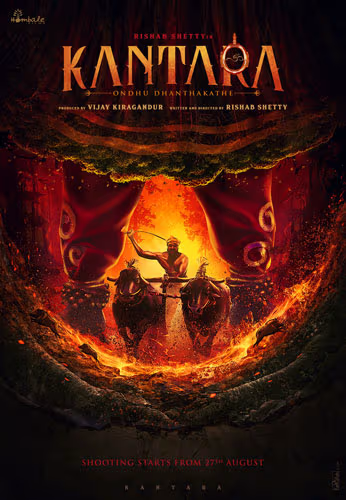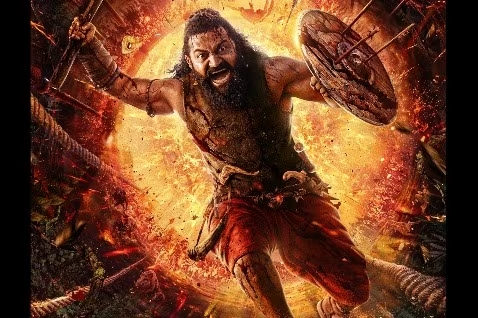Rishab Shetty is getting ready for the prequel to his hit 2022 Kannada film, Kantara. On his birthday, he shared a powerful first-look poster from Kantara Chapter 1 on social media. The intense new look has excited fans and created a lot of buzz online.
In 2022, a Kannada-language film shook the foundations of Indian cinema. Kantara, written and directed by Rishab Shetty, captivated audiences with its powerful mix of folklore, mysticism, and raw storytelling. It became more than a movie—it was a cultural moment. Now, as the cinematic universe expands with Kantara: Chapter 1, fans eagerly await a deeper dive into the mythological world introduced in the original.
Let’s explore what Kantara: Chapter 1 promises, how it builds on the original film’s legacy, and why this universe is becoming a significant force in Indian—and even global—cinema.
Kantara Chapter 1 – The Prequel We’ve Been Waiting For
Following the phenomenal success of Kantara, Hombale Films announced Kantara: Chapter 1, a prequel that travels centuries into the past to unravel the deeper spiritual and mythological roots of the original story. Scheduled for a worldwide release on October 2, 2025, this chapter marks a strategic expansion of the franchise.
A Pan-India Vision from the Start
Unlike the original film, which saw a gradual pan-India rollout due to rising demand, Kantara: Chapter 1 is being launched across five major Indian languages—Kannada, Hindi, Tamil, Telugu, and Malayalam—from day one. This marks a deliberate move by the producers to capture the national market and extend their global footprint. And with no major releases expected in early October, the release timing is calculated to give the film an open runway at the box office.
Setting and Story – A Dive into Ancient Karnataka
What sets Kantara: Chapter 1 apart is its ambitious narrative setting. Set approximately 300 years before the events of the original, the prequel is expected to take place during the Kadamba Dynasty era (4th–6th century AD)—a time rich in history and mythology.
The story focuses on the origins of Bhoota Kola, the traditional spirit-worship ritual central to Kantara, and explores Shiva’s ancestral legacy. The ancient conflict between man and nature—a theme that resonated deeply in the original—is expected to be explored in even greater depth. Director Rishab Shetty has teased a darker, more mystical tone, larger-than-life sequences, and stunning visuals, signaling a shift toward a mythological epic.
Cast and Crew – Bigger, Better, Yet Familiar
Rishab Shetty returns not just as director but also as the lead actor, portraying a younger Kadubettu Shiva. This continuity is a deliberate creative decision to maintain the raw emotional intensity that defined the original film. The supporting cast includes Sapthami Gowda, Achyuth Kumar, Manasi Sudhir, and others. There’s also speculation about a major Bollywood actor joining the project as the antagonist—possibly a tyrannical king.
Behind the scenes, the original technical team is also making a comeback:
- Ajaneesh Loknath reprises his role as music composer, expected to deliver another folklore-heavy soundtrack.
- Arvind S. Kashyap, who elevated the original with his gripping cinematography, returns as Director of Photography.
And here’s the big difference: the film’s budget exceeds ₹100 crores, a tenfold jump from the original’s modest ₹16 crore budget. This financial backing is earmarked for authentic period sets, intense VFX sequences, epic war scenes, and a massive global marketing campaign.
Behind the Scenes – Rishab Shetty’s Immersive Commitment
Few actors immerse themselves into a role quite like Rishab Shetty. For Kantara: Chapter 1, he spent a year growing out his hair and beard, and trained in horse-riding, Kalari martial arts, and sword fighting to portray Shiva authentically. The shoot has remained under tight wraps, with secrecy maintained to build anticipation.
One hiccup occurred when a boat carrying Shetty and crew capsized during filming at Karnataka’s Mani reservoir. Fortunately, there were no injuries, but expensive equipment was lost. The incident underscores the challenges of shooting in rugged, natural terrains—a trademark of the franchise’s gritty aesthetic.

The Legacy of Kantara (2022): Why It Still Matters
The original Kantara wasn’t just a surprise box office hit; it was a cultural phenomenon. Upon its release, the film became the second highest-grossing Kannada film ever, only behind KGF: Chapter 2, and one of India’s top-grossing films in 2022.
Critics and audiences alike praised it for:
- Its powerful depiction of indigenous rituals like Bhoota Kola
- The immersive sound design and cinematography
- A climactic spiritual transformation that left viewers spellbound
International audiences embraced it too. In just weeks, Kantara grossed millions in North America, the Middle East, and Australia, and ultimately crossed the ₹400 crore global box office mark.
More Than Entertainment: A Cultural Awakening
“Local is the new global,” said Rishab Shetty—and Kantara proved it. The film shone a spotlight on Tulu Nadu’s coastal culture, integrating elements like:
- Yakshagana (folk theatre)
- Kambala (buffalo racing)
- Paddanas (folk songs about deities and heroes)
The core of Kantara revolved around the idea that gods walk among us—“Daivam Manushya Rupena”—and that harmony with nature is both spiritual and moral. This thematic depth made the film feel not just entertaining but transformative.
Scholars even analyzed the film using Mikhail Bakhtin’s chronotope and carnivalesque theories, which explore how cultural performances invert power dynamics and reveal deep societal truths. Bhoota Kola, central to Kantara, was shown not just as a ritual, but as a bridge between gods and the oppressed, giving power to the voiceless, even if temporarily.
The Film That Changed Policy
Kantara’s impact went beyond screens and reviews. The Karnataka government announced a monthly pension for aged Bhoota Kola performers after the film’s success—one of the rare instances where a film directly influenced cultural policy.
It also encouraged other regional filmmakers to explore their roots. Rishab Shetty’s success story has become a beacon for regional storytellers: be honest, be local, and audiences will come.
Looking Ahead – Will the Magic Continue?
With Kantara: Chapter 1, Hombale Films is betting big—not just financially, but narratively. A third film is already rumored, potentially setting up a fully developed Kantara Cinematic Universe.
The challenges? Maintaining the spiritual authenticity that defined the original while expanding the universe into something bigger. The risk of diluting the original’s rawness with CGI and commercial tropes is real—but so is the potential to create something truly mythic and enduring.
Conclusion
Kantara was never just about a man or a village. It was about a culture, a belief system, and the eternal dance between man, nature, and divinity. As Kantara: Chapter 1 gears up for release, the expectations are sky-high. But with Rishab Shetty at the helm, a dedicated cast and crew, and a production house known for delivering hits, this cinematic universe might just become the next defining franchise in Indian cinema.
Whether you watch it for the mythology, the action, the visuals, or the message—Kantara continues to be a powerful reminder that the most rooted stories often reach the farthest hearts.







